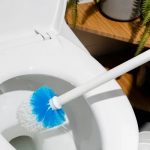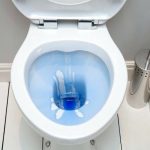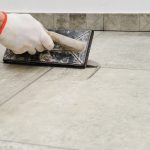You can remove gray stains from bathtubs made of porcelain using the techniques and products we have discussed here.
For starters, you should wash your bathtub thoroughly. Then, you need to pour a little bit of bleach into the tub.
Once the stain is spread evenly across the tub, you can rinse it with water. So, how do you remove gray stains from a bathtub?
Gray stains in bathtubs are annoying, but they can be easily cleaned using vinegar and baking soda. First, sprinkle baking soda over the gray stains in the tub.
Next, pour white vinegar over the baking soda and stir until it blends in. The baking soda will soak up the vinegar, and the stain will fade gradually.
Finally, clean the tub using water and dish soap. The stain will be gone in no time!
Contents
How To Remove Gray Stains In Bathtub
Wipe Off Debris In The Tub
Bathtub stains that appear like light gray lines can be the result of accumulated debris in the tub.
Begin with the fundamentals by wiping down the bath with a sponge or cloth soaked in warm water and liquid dish soap to remove grime and other particles.
These tubs frequently acquire a buildup of hard water and mineral deposits over time, which settle onto the sides of the tub and cause discoloration and tarnishing of these surfaces.
If you wish to remove gray staining from bathtubs made of porcelain, you can try to remove the buildup yourself by utilizing chemicals such as household cleaners or acid-based cleansers such as muriatic acid or hydrochloric acid.
Many individuals try to remove the deposits using these chemical solutions without understanding the dangers associated with using such substances on porcelain bathtubs.
This creates a situation where some white spots remain after the stain is removed, making the whole procedure worthless.
Apply Clorox Or Stain Remover
When you are happy with the debris removal, the next step would be to apply a strong solution of bleach to your bath.
You will have a more difficult time removing the spots left by this cleaner, but it will do the best job of removing the stained area itself.
Clorox, Comet, or a similarly strong solution ought to be used carefully and only on a surface that is covered to prevent splattering onto the surrounding walls and floor.
The idea is to apply a cleaning product to the discolored area of your bath and let it sit for a couple of minutes before you scrub it away with a toothbrush or similar brush to loosen up the stubborn marks.
These gray stains in a tub are from minerals in the water that deposit on the porcelain surface over a period of time.
Apply the cleaning product directly over the discoloration and leave it sit for a few minutes before you remove it with a wet rag or sponge.
Scrub Using A Brush
You’re going to need to scrub these gray stains out of your bathtub with a brush of some sort.
The objective is to ensure that any chemicals you utilize don’t wind up damaging your bathtub’s finish in the process.
Find a non-abrasive scrubbing pad with a soft bristle brush that will safely remove mineral deposits without damaging your tub’s porcelain finish.
The goal is to make sure you’re only applying cleaning products to the discolored area of the tub and not the surrounding area of the walls or floor.
This is how you will get rid of the gray spots in your bathtub while ensuring you do not damage the finish of your bathtub at the same time.
Continue to work on the stain until it fades completely, and then rinse the area thoroughly with clean water before drying it off with a clean towel.
Repeat The Process
You will want to repeat this process several times until you have removed all of the discoloration from your tub.
This will finally allow you to enjoy your brand-new, clean-looking bathroom once again.
Gray stains can be stubborn in even the toughest of situations, but with the right products and the right technique, you’ll be able to get them out successfully and easily in no time flat.
There is nothing wrong with this. Many homes have fixtures that have this kind of staining on them, and it’s not really a problem, as long as it’s not too severe and is not affecting the look and functionality of the fixture in question.
Repeat the steps until you get rid of all of the stains in your bathtub. Then, continue to keep your new, clean looking bathroom clean by wiping it down regularly with a damp cloth to keep it free of germs and bacteria.
What Causes Grey Stains in Bathtub?
Soap scum is a filmy material with alkaline properties that builds up over time on the surface of your bath tub when bathing with soap and shampoo, leaving unsightly residue and hard water spots that result in grey marks on white bathtubs.
Installing a water softening system will reduce the amount of calcium in your water, which also helps eliminate hard water stains from bathtubs, sinks, toilets, and other surfaces.
Switching to liquid soap will also help reduce soap scum build-up on tubs and eliminate hard water deposits that stain white tubs a grey color.
Can You Mix Baking Soda and White Vinegar Together?
These two everyday home items may be mixed together in a variety of different cleaning solutions.
Because vinegar and baking soda have different pH levels, when mixed together, they create an acidic solution, which is effective at cleaning your toilet bowl and removing tough toilet rings and other mineral deposits.
Can Bleach Damage a Bathtub?
Because enameled cast iron and acrylic tubs are especially vulnerable, using bleach can weaken their enamel finishes and cause them to peel over time.
Any bleach should be used with a cloth or sponge to avoid ruining the finish on your tub, and it should be wiped away immediately to avoid damage.
Also Read: Can You Wash Bathroom Rugs With Towels?
Final Words
These suggestions should be sufficient to ensure you can remove the gray stains from your bathtub and restore it to its previous appearance once again.
Gray stains in the bathtub can detract from the appearance of your bathroom and make you wish you had done something about them sooner.
This produces a visible chalky film on surfaces such as glass shower doors and tile walls, which can be very difficult to remove without causing damage to those surfaces.
Wipe the affected area with a clean towel, being careful not to scratch the surface while removing any remaining particles of dirt or grime from the surface.
If required, repeat this step until all of the debris has been removed.
This should be more than enough to reduce or eliminate the gray staining in your tub.
For many people, this provides all the guidance they need to eliminate any discoloration on their bathroom fixtures.
For others, the soap stains will reappear repeatedly without apparent cause.






